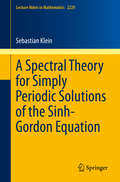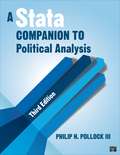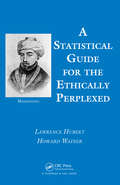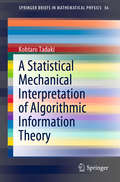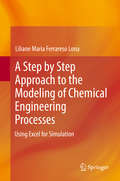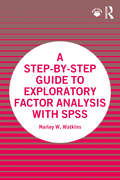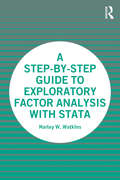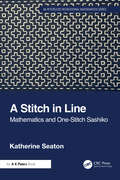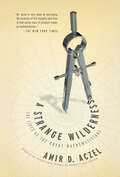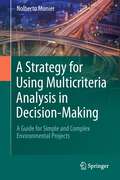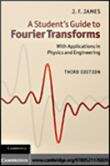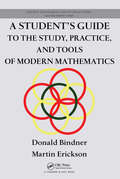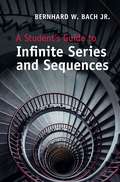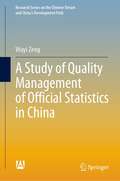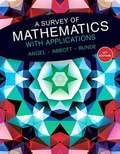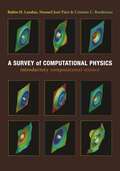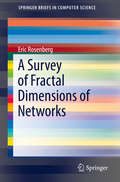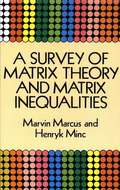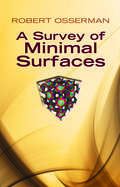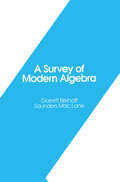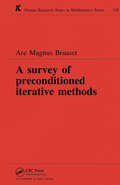- Table View
- List View
A Spectral Theory for Simply Periodic Solutions of the Sinh-Gordon Equation (Lecture Notes in Mathematics #2229)
by Sebastian KleinThis book develops a spectral theory for the integrable system of 2-dimensional, simply periodic, complex-valued solutions u of the sinh-Gordon equation. Such solutions (if real-valued) correspond to certain constant mean curvature surfaces in Euclidean 3-space. Spectral data for such solutions are defined (following ideas of Hitchin and Bobenko) and the space of spectral data is described by an asymptotic characterization. Using methods of asymptotic estimates, the inverse problem for the spectral data is solved along a line, i.e. the solution u is reconstructed on a line from the spectral data. Finally, a Jacobi variety and Abel map for the spectral curve are constructed and used to describe the change of the spectral data under translation of the solution u. The book's primary audience will be research mathematicians interested in the theory of infinite-dimensional integrable systems, or in the geometry of constant mean curvature surfaces.
A Star in My Orange: Looking for Nature's Shapes
by Dana Meachen RauThis book introduces the child to different geometric shapes seen in nature.
A Stata Companion to Political Analysis (Third Edition)
by Philip H. PollockWith this Third Edition, students quickly learn Stata with step-by-step instructions, more than 50 exercises, customized data sets, annotated screen shots, boxes that highlight Stata's capabilities, and guidance on using Stata to read raw data.
A Statistical Guide for the Ethically Perplexed
by Howard Wainer Lawrence HubertExploring the intersection of ethics and statistics, this comprehensive guide illustrates the proper use of probabilistic and statistical reasoning in the behavioral, social, and biomedical sciences. Lauded for their contributions to statistics, psychology, and psychometrics, the authors make statistical methods relevant to readers' day-to-day lives by including real historical situations that demonstrate the role of statistics in reasoning and decision making. In addition, seven U.S. Supreme Court decisions reflect the influence of statistical and psychometric reasoning and interpretation/misinterpretation.
A Statistical Mechanical Interpretation of Algorithmic Information Theory (SpringerBriefs in Mathematical Physics #36)
by Kohtaro TadakiThis book is the first one that provides a solid bridge between algorithmic information theory and statistical mechanics. Algorithmic information theory (AIT) is a theory of program size and recently is also known as algorithmic randomness. AIT provides a framework for characterizing the notion of randomness for an individual object and for studying it closely and comprehensively. In this book, a statistical mechanical interpretation of AIT is introduced while explaining the basic notions and results of AIT to the reader who has an acquaintance with an elementary theory of computation.A simplification of the setting of AIT is the noiseless source coding in information theory. First, in the book, a statistical mechanical interpretation of the noiseless source coding scheme is introduced. It can be seen that the notions in statistical mechanics such as entropy, temperature, and thermal equilibrium are translated into the context of noiseless source coding in a natural manner. Then, the framework of AIT is introduced. On this basis, the introduction of a statistical mechanical interpretation of AIT is begun. Namely, the notion of thermodynamic quantities, such as free energy, energy, and entropy, is introduced into AIT. In the interpretation, the temperature is shown to be equal to the partial randomness of the values of all these thermodynamic quantities, where the notion of partial randomness is a stronger representation of the compression rate measured by means of program-size complexity. Additionally, it is demonstrated that this situation holds for the temperature itself as a thermodynamic quantity. That is, for each of all the thermodynamic quantities above, the computability of its value at temperature T gives a sufficient condition for T to be a fixed point on partial randomness.In this groundbreaking book, the current status of the interpretation from both mathematical and physical points of view is reported. For example, a total statistical mechanical interpretation of AIT that actualizes a perfect correspondence to normal statistical mechanics can be developed by identifying a microcanonical ensemble in the framework of AIT. As a result, the statistical mechanical meaning of the thermodynamic quantities of AIT is clarified. In the book, the close relationship of the interpretation to Landauer's principle is pointed out.
A Step by Step Approach to the Modeling of Chemical Engineering Processes
by Liliane Maria Ferrareso LonaThis book treats modeling and simulation in a simple way, that builds on the existing knowledge and intuition of students. They will learn how to build a model and solve it using Excel.Most chemical engineering students feel a shiver down the spine when they see a set of complex mathematical equations generated from the modeling of a chemical engineering system. This is because they usually do not understand how to achieve this mathematical model, or they do not know how to solve the equations system without spending a lot of time and effort.Trying to understand how to generate a set of mathematical equations to represent a physical system (to model) and solve these equations (to simulate) is not a simple task. A model, most of the time, takes into account all phenomena studied during a Chemical Engineering course. In the same way, there is a multitude of numerical methods that can be used to solve the same set of equations generated from the modeling, and many different computational languages can be adopted to implement the numerical methods. As a consequence of this comprehensiveness and combinatorial explosion of possibilities, most books that deal with this subject are very extensive and embracing, making need for a lot of time and effort to go through this subject. It is expected that with this book the chemical engineering student and the future chemical engineer feel motivated to solve different practical problems involving chemical processes, knowing they can do that in an easy and fast way, with no need of expensive software.
A Step-by-Step Guide to Exploratory Factor Analysis with SPSS
by Marley W. WatkinsThis is a concise, easy-to-use, step-by-step guide for applied researchers conducting exploratory factor analysis (EFA) using SPSS.
A Step-by-Step Guide to Exploratory Factor Analysis with Stata
by Marley W. WatkinsThis is a concise, easy to use, step-by-step guide for applied researchers conducting exploratory factor analysis (EFA) using Stata. In this book, Dr. Watkins systematically reviews each decision step in EFA with screen shots of Stata code and recommends evidence-based best practice procedures. This is an eminently applied, practical approach with few or no formulas and is aimed at readers with little to no mathematical background. Dr. Watkins maintains an accessible tone throughout and uses minimal jargon and formula to help facilitate grasp of the key issues users will face when applying EFA, along with how to implement, interpret, and report results. Copious scholarly references and quotations are included to support the reader in responding to editorial reviews. This is a valuable resource for upper level undergraduate and postgraduate students, as well as for more experienced researchers undertaking multivariate or structure equation modeling courses across the behavioral, medical, and social sciences.
A Stitch in Line: Mathematics and One-Stitch Sashiko (AK Peters/CRC Recreational Mathematics Series)
by Katherine SeatonA Stitch in Line: Mathematics and One-Stitch Sashiko provides readers with instructions for creating hitomezashi items with minimum outlay. The reader is guided through the practical steps involved in creating each design, and then the mathematics which underpins it is explained in a friendly, accessible way. This is a fantastic book for anyone who is interested in recreational mathematics and/or fibre arts and can be a useful resource for teaching and learning mathematical concepts in a fun and engaging format. Features Numerous full-colour photographs of hitomezashi stitch patterns which have been mathematically designed. Suitable for readers of all mathematical levels and backgrounds — no prior knowledge is automatically assumed. A compressed encoding for recording and designing hitomezashi patterns to be stitched or drawn. Accessible explanations and explorations of mathematical concepts inherent in, or illustrated by, hitomezashi patterns.
A Strange Wilderness: The Lives of the Great Mathematicians
by Amir D. Aczel“Mathematics is not a careful march down a well-cleared highway, but a journey into a strange wilderness, where the explorers often get lost.”-- Mathematics historian W. S. Anglin From the internationally bestselling author of Fermats Last Theorem comes a landmark publication on the eccentric lives of the foremost mathematicians in history..From Archimedes eureka moment to Alexander Grothendiecks seclusion in the Pyrenees, bestselling author Amir Aczel selects the most compelling stories in the history of mathematics, creating a colorful narrative that explores the quirky personalities behind some of the most groundbreaking, enduring theorems. This is not your dry “college textbook” account of mathematical history; it bristles with tales of duels, battlefield heroism, flamboyant arrogance, pranks, secret societies, imprisonment, feuds, theft, and some very costly errors of judgment. (Clearly, genius doesnt guarantee street smarts.) Ultimately, readers will come away entertained, and with a newfound appreciation of the tenacity, complexity, eccentricity, and brilliance of the mathematical genius.
A Strategy for Using Multicriteria Analysis in Decision-Making: A Guide for Simple and Complex Environmental Projects
by Nolberto MunierThis book develops a whole strategy for decision-making, with the full participation of the decision-maker and utilizing continuous feedback. It introduces the use of the very well-known and proven methodology, linear programming, but specially adapted for this purpose. For this, it incorporates a method to include subjective concepts, as well as the possibility of working with many different and even contradictory objectives. The book is liberally populated with diverse case studies to illustrate the concepts. This practical guide will be of interest to anyone undertaking analysis and decision-making, on both simple and complex projects, and who is looking for a strategy to organize, classify, and evaluate the large amount of information required to make an informed decision. The strategy includes methods to analyze the results and extract conclusions from them.
A Student's Guide to Fourier Transforms
by J. F. JamesFourier transform theory is of central importance in a vast range of applications in physical science, engineering, and applied mathematics. This new edition of a successful student text provides a concise introduction to the theory and practice of Fourier transforms, using qualitative arguments wherever possible and avoiding unnecessary mathematics. After a brief description of the basic ideas and theorems, the power of the technique is then illustrated by referring to particular applications in optics, spectroscopy, electronics and telecommunications. The rarely discussed but important field of multi-dimensional Fourier theory is covered, including a description of computer-aided tomography (CAT-scanning). The final chapter discusses digital methods, with particular attention to the fast Fourier transform. Throughout, discussion of these applications is reinforced by the inclusion of worked examples. The book assumes no previous knowledge of the subject, and will be invaluable to students of physics, electrical and electronic engineering, and computer science.
A Student's Guide to Geophysical Equations
by William LowrieThe advent of accessible student computing packages has meant that geophysics students can now easily manipulate datasets and gain first-hand modeling experience - essential in developing an intuitive understanding of the physics of the Earth. Yet to gain a more in-depth understanding of physical theory, and to develop new models and solutions, it is necessary to be able to derive the relevant equations from first principles. This compact, handy book fills a gap left by most modern geophysics textbooks, which generally do not have space to derive all of the important formulae, showing the intermediate steps. This guide presents full derivations for the classical equations of gravitation, gravity, tides, earth rotation, heat, geomagnetism and foundational seismology, illustrated with simple schematic diagrams. It supports students through the successive steps and explains the logical sequence of a derivation - facilitating self-study and helping students to tackle homework exercises and prepare for exams.
A Student's Guide to Lagrangians and Hamiltonians
by Patrick HamillA concise but rigorous treatment of variational techniques, focussing primarily on Lagrangian and Hamiltonian systems, this book is ideal for physics, engineering and mathematics students. The book begins by applying Lagrange's equations to a number of mechanical systems. It introduces the concepts of generalized coordinates and generalized momentum. Following this the book turns to the calculus of variations to derive the Euler–Lagrange equations. It introduces Hamilton's principle and uses this throughout the book to derive further results. The Hamiltonian, Hamilton's equations, canonical transformations, Poisson brackets and Hamilton–Jacobi theory are considered next. The book concludes by discussing continuous Lagrangians and Hamiltonians and how they are related to field theory. Written in clear, simple language and featuring numerous worked examples and exercises to help students master the material, this book is a valuable supplement to courses in mechanics.
A Student's Guide to Numerical Methods
by Ian H. HutchinsonThis concise, plain-language guide for senior undergraduates and graduate students aims to develop intuition, practical skills and an understanding of the framework of numerical methods for the physical sciences and engineering. It provides accessible self-contained explanations of mathematical principles, avoiding intimidating formal proofs. Worked examples and targeted exercises enable the student to master the realities of using numerical techniques for common needs such as solution of ordinary and partial differential equations, fitting experimental data, and simulation using particle and Monte Carlo methods. Topics are carefully selected and structured to build understanding, and illustrate key principles such as: accuracy, stability, order of convergence, iterative refinement, and computational effort estimation. Enrichment sections and in-depth footnotes form a springboard to more advanced material and provide additional background. Whether used for self-study, or as the basis of an accelerated introductory class, this compact textbook provides a thorough grounding in computational physics and engineering.
A Student's Guide to the Study, Practice, and Tools of Modern Mathematics (Discrete Mathematics and Its Applications)
by Martin Erickson Donald BindnerA Student's Guide to the Study, Practice, and Tools of Modern Mathematics provides an accessible introduction to the world of mathematics. It offers tips on how to study and write mathematics as well as how to use various mathematical tools, from LaTeX and Beamer to Mathematica and Maple to MATLAB and R. Along with a color insert, the text include
A Student’s Guide to Infinite Series and Sequences
by Bernhard W. Bach Jr.Why study infinite series? Not all mathematical problems can be solved exactly or have a solution that can be expressed in terms of a known function. In such cases, it is common practice to use an infinite series expansion to approximate or represent a solution. <P><P>This informal introduction for undergraduate students explores the numerous uses of infinite series and sequences in engineering and the physical sciences. The material has been carefully selected to help the reader develop the techniques needed to confidently utilize infinite series. <P>The book begins with infinite series and sequences before moving onto power series, complex infinite series and finally onto Fourier, Legendre, and Fourier-Bessel series. With a focus on practical applications, the book demonstrates that infinite series are more than an academic exercise and helps students to conceptualize the theory with real world examples and to build their skill set in this area.<P> An informal, plain language approach enables the student to get to grips with the material quickly.<P> A focus on practical real-world examples ensures a complex topic is accessible for students.<P> The early introduction of complex numbers allows the reader to apply infinite series to applications that are typically only addressed in high level mathematics courses.<P>
A Study of Quality Management of Official Statistics in China (Research Series on the Chinese Dream and China’s Development Path)
by Wuyi ZengThis book focuses on how to improve the quality management of official statistics in China. Official statistics help to build an overview of China’s social and economic development and play an important role in policymaking for government as well as in decision-making for enterprises. Because of the great value in reference, the quality of official statistics also constitutes the concern from the public. This book summarizes three levels for understanding the concept of the quality of official statistics and analyzes possible affections from social and economic environment, political and management perspectives. Government statistical data is an important information reflecting China’s economic and social development, an important tool for Party committees at all levels, governments, enterprises and the public to understand and grasp China’s economic operation and social development, an important basis for Party committees and governments at all levels to conduct economic and social management and decision-making and an important reference for enterprises and the public to make decisions on production, operation, investment and consumption. Therefore, the government, enterprises and the public at all levels are demanding more and more government statistics. Accordingly, the quality of government statistical data is becoming more and more important, because it concerns the objectivity and accuracy of government statistical data, the scientificity of economic and social management, the decision-making of Party committees, the correctness of production, operation, investment and consumption decisions of enterprises and the public. Therefore, the quality of government statistical data is extremely important, which is not only the focus of social concern, but also the core issue of government statistics.
A Survey Of Mathematics With Applications
by Allen R. Angel Christine D. Abbott Dennis C. RundeMathematics is an exciting, living study. Its applications shape the world around you and influence your everyday life. We hope that as you read this book you will realize just how important mathematics is and gain an appreciation of both its usefulness and its beauty. We also hope to teach you some practical mathematics that you can use every day and that will prepare you for further mathematics courses. The primary purpose of this text is to provide material that you can read, under¬stand, and enjoy. To this end, we have used straightforward language and tried to re¬late the mathematical concepts to everyday experiences. We have also provided many detailed examples for you to follow.
A Survey of Computational Physics: Introductory Computational Science
by Cristian C. Bordeianu José Páez Rubin LandauComputational physics is a rapidly growing subfield of computational science, in large part because computers can solve previously intractable problems or simulate natural processes that do not have analytic solutions. The next step beyond Landau's First Course in Scientific Computing and a follow-up to Landau and Páez's Computational Physics, this text presents a broad survey of key topics in computational physics for advanced undergraduates and beginning graduate students, including new discussions of visualization tools, wavelet analysis, molecular dynamics, and computational fluid dynamics. By treating science, applied mathematics, and computer science together, the book reveals how this knowledge base can be applied to a wider range of real-world problems than computational physics texts normally address. Designed for a one- or two-semester course, A Survey of Computational Physics will also interest anyone who wants a reference on or practical experience in the basics of computational physics. Accessible to advanced undergraduates Real-world problem-solving approach Java codes and applets integrated with text Companion Web site includes videos of lectures
A Survey of Fractal Dimensions of Networks (SpringerBriefs in Computer Science)
by Eric RosenbergMany different fractal dimensions have been proposed for networks. In A Survey of Fractal Dimensions of Networks the theory and computation of the most important of these dimensions are reviewed, including the box counting dimension, the correlation dimension, the mass dimension, the transfinite fractal dimension, the information dimension, the generalized dimensions (which provide a way to describe multifractals), and the sandbox method (for approximating the generalized dimensions). The book describes the use of diameter-based and radius-based boxes, and presents several heuristic methods for box counting, including greedy coloring, random sequential node burning, and a method for computing a lower bound. We also discuss very recent results on resolving ambiguity in the calculation of the information dimension and the generalized dimensions, and on the non-monotonicity of the generalized dimensions. Anyone interested in the theory and application of networks will want to read this Brief. This includes anyone studying, e.g., social networks, telecommunications networks, transportation networks, ecological networks, food chain networks, network models of the brain, or financial networks.
A Survey of Matrix Theory and Matrix Inequalities (Dover Books on Mathematics)
by Marvin Marcus Henryk MincWritten for advanced undergraduate students, this highly regarded book presents an enormous amount of information in a concise and accessible format. Beginning with the assumption that the reader has never seen a matrix before, the authors go on to provide a survey of a substantial part of the field, including many areas of modern research interest.Part One of the book covers not only the standard ideas of matrix theory, but ones, as the authors state, "that reflect our own prejudices," among them Kronecker products, compound and induced matrices, quadratic relations, permanents, incidence matrices and generalizations of commutativity.Part Two begins with a survey of elementary properties of convex sets and polyhedra and presents a proof of the Birkhoff theorem on doubly stochastic matrices. This is followed by a discussion of the properties of convex functions and a list of classical inequalities. This material is then combined to yield many of the interesting matrix inequalities of Weyl, Fan, Kantorovich and others. The treatment is along the lines developed by these authors and their successors and many of their proofs are included. This chapter contains an account of the classical Perron Frobenius-Wielandt theory of indecomposable nonnegative matrices and ends with some important results on stochastic matrices.Part Three is concerned with a variety of results on the localization of the characteristic roots of a matrix in terms of simple functions of its entries or of entries of a related matrix. The presentation is essentially in historical order, and out of the vast number of results in this field the authors have culled those that seemed most interesting or useful. Readers will find many of the proofs of classical theorems and a substantial number of proofs of results in contemporary research literature.
A Survey of Minimal Surfaces (Dover Books on Mathematics)
by Robert OssermanNewly updated accessible study covers parametric and non-parametric surfaces, isothermal parameters, Bernstein's theorem, much more, including such recent developments as new work on Plateau's problem and on isoperimetric inequalities. Clear, comprehensive examination provides profound insights into crucial area of pure mathematics. 1986 edition. Index.
A Survey of Modern Algebra
by Garrett Birkhoff Saunders Mac LaneThis classic, written by two young instructors who became giants in their field, has shaped the understanding of modern algebra for generations of mathematicians and remains a valuable reference and text for self study and college courses.
A Survey of Preconditioned Iterative Methods (Research Notes In Mathematics Ser.)
by Are Magnus BruasetThe problem of solving large, sparse, linear systems of algebraic equations is vital in scientific computing, even for applications originating from quite different fields. A Survey of Preconditioned Iterative Methods presents an up to date overview of iterative methods for numerical solution of such systems. Typically, the methods considered are w
